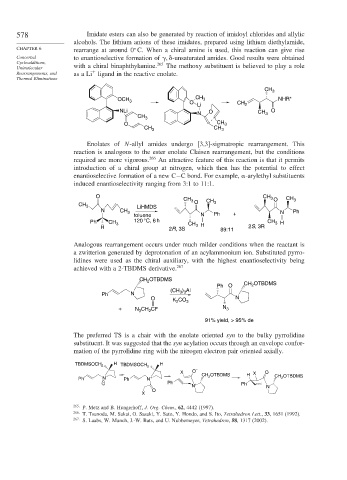Page 604 - Advanced Organic Chemistry Part B - Reactions & Synthesis
P. 604
578 Imidate esters can also be generated by reaction of imidoyl chlorides and allylic
alcohols. The lithium anions of these imidates, prepared using lithium diethylamide,
CHAPTER 6 rearrange at around 0 C. When a chiral amine is used, this reaction can give rise
Concerted to enantioselective formation of
-unsaturated amides. Good results were obtained
Cycloadditions, 265
Unimolecular with a chiral binaphthylamine. The methoxy substituent is believed to play a role
+
Rearrangements, and asaLi ligand in the reactive enolate.
Thermal Eliminations
CH 3
OCH 3 O CH 3 NHR*
Li CH 2
NLi O CH O
N 3
CH 3
O CH 3
CH 3 CH 3
Enolates of N-allyl amides undergo [3,3]-sigmatropic rearrangement. This
reaction is analogous to the ester enolate Claisen rearrangement, but the conditions
required are more vigorous. 266 An attractive feature of this reaction is that it permits
introduction of a chiral group at nitrogen, which then has the potential to effect
enantioselective formation of a new C−C bond. For example, -arylethyl substituents
induced enantioselectivity ranging from 3:1 to 11:1.
O CH
CH 3 CH 3 O CH 3
CH 3 LiHMDS O 3
N CH 3 N Ph
toluene N Ph +
Ph CH 3 120 °C, 6 h CH 3 H
H 2R, 3S CH 3 H 89:11 2S, 3R
Analogous rearrangement occurs under much milder conditions when the reactant is
a zwitterion generated by deprotonation of an acylammonium ion. Substituted pyrro-
lidines were used as the chiral auxiliary, with the highest enantioselectivity being
achieved with a 2-TBDMS derivative. 267
CH OTBDMS
2
2
Ph O CH OTBDMS
) Al
(CH 3 3
Ph N
O K CO 3 N
2
+ N 3 CH CF N 3
2
91% yield, > 95% de
The preferred TS is a chair with the enolate oriented syn to the bulky pyrrolidine
substituent. It was suggested that the syn acylation occurs through an envelope confor-
mation of the pyrrolidine ring with the nitrogen electron pair oriented axially.
TBDMSOCH H TBDMSOCH H
2 2
X O – CH OTBDMS H X O
2
Ph N Ph N + 2 CH OTBDMS
: Ph + Ph
N N
O
X
265 P. Metz and B. Hungerhoff, J. Org. Chem., 62, 4442 (1997).
266 T. Tsunoda, M. Sakai, O. Sasaki, Y. Sato, Y. Hondo, and S. Ito, Tetrahedron Lett., 33, 1651 (1992).
267
S. Laabs, W. Munch, J.-W. Bats, and U. Nubbemeyer, Tetrahedron, 58, 1317 (2002).

